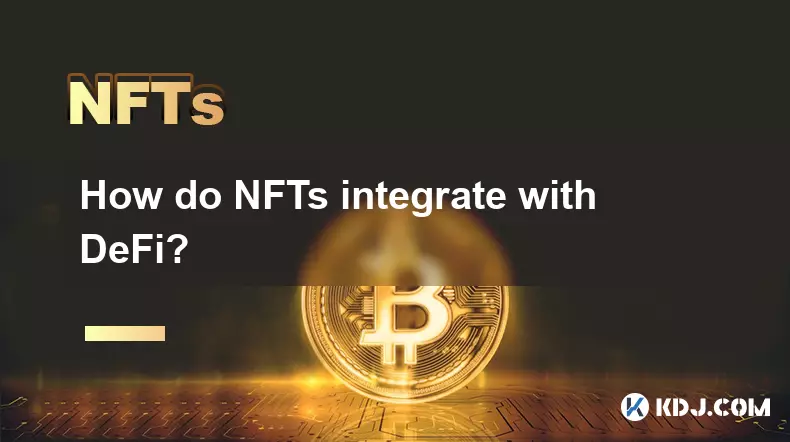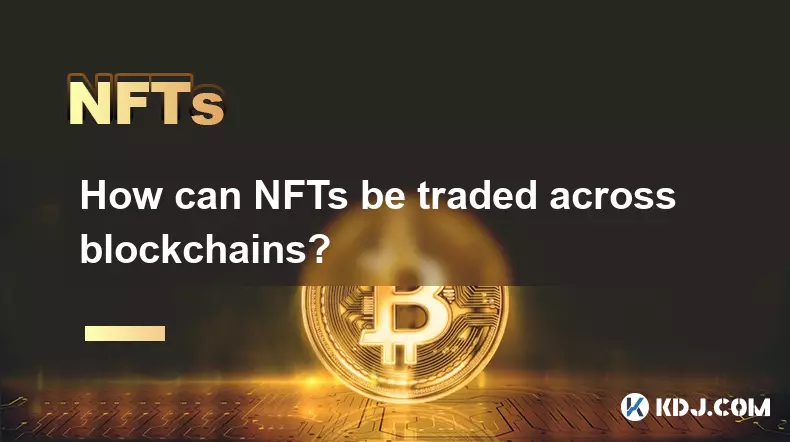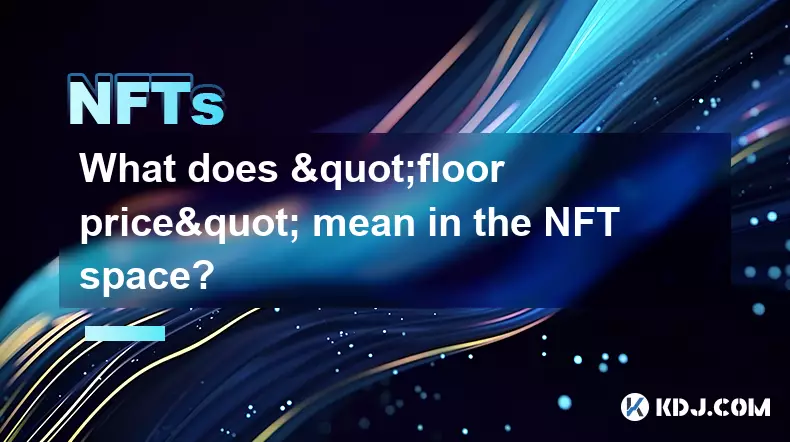-
 bitcoin
bitcoin $109667.069529 USD
-3.03% -
 ethereum
ethereum $3936.685804 USD
-4.07% -
 tether
tether $1.000493 USD
0.01% -
 xrp
xrp $2.771823 USD
-4.74% -
 bnb
bnb $957.805027 USD
-5.34% -
 solana
solana $196.735100 USD
-6.68% -
 usd-coin
usd-coin $0.999727 USD
-0.01% -
 dogecoin
dogecoin $0.227355 USD
-5.12% -
 tron
tron $0.335205 USD
-0.81% -
 cardano
cardano $0.779256 USD
-3.59% -
 ethena-usde
ethena-usde $0.999900 USD
-0.06% -
 hyperliquid
hyperliquid $42.492095 USD
-6.61% -
 chainlink
chainlink $20.501853 USD
-4.34% -
 avalanche
avalanche $28.952606 USD
-11.21% -
 stellar
stellar $0.356038 USD
-3.93%
How do NFTs integrate with DeFi?
The integration of NFTs and DeFi unlocks liquidity, enables collateralized loans, fractional ownership, and governance, transforming digital assets into functional financial instruments.
Sep 18, 2025 at 06:36 am

Understanding the Intersection of NFTs and DeFi
1. Non-fungible tokens (NFTs) represent unique digital assets verified using blockchain technology, commonly associated with digital art, collectibles, and virtual real estate. Unlike cryptocurrencies such as Bitcoin or Ethereum, each NFT holds distinct properties that prevent interchangeability. Decentralized Finance (DeFi), on the other hand, refers to a financial ecosystem built on public blockchains where users can lend, borrow, trade, and earn interest without relying on traditional intermediaries like banks.
2. The integration of NFTs into DeFi has unlocked new utility beyond ownership and speculation. By leveraging smart contracts, NFTs are being used as collateral in lending protocols, enabling asset-backed borrowing in a trustless environment. This fusion allows individuals to unlock liquidity from otherwise illiquid digital assets.
3. Platforms such as Aave and MakerDAO have introduced mechanisms where NFTs can be appraised and deposited to secure loans. While valuation remains a challenge due to the uniqueness of each token, emerging oracle solutions aim to provide more accurate pricing data based on historical sales, rarity scores, and market demand.
4. Fractional ownership is another key development bridging NFTs and DeFi. Protocols like Unicrypt and NFTX allow high-value NFTs to be divided into fungible shares, which can then be traded on decentralized exchanges. This lowers entry barriers for retail investors and increases market efficiency.
5. Yield-generating NFTs are also gaining traction. Certain projects issue NFTs that accrue value over time through staking rewards or revenue sharing from platform fees. These hybrid assets combine collectibility with financial incentives, aligning interests between creators, collectors, and investors.
Liquidity Solutions Enabled by NFT-DeFi Integration
1. One of the most persistent challenges in the NFT space is low liquidity. Traditional marketplaces rely on bilateral trades, often resulting in long waiting periods between offers. DeFi-powered liquidity pools address this by allowing NFT holders to deposit their tokens alongside stablecoins or ETH into automated market makers (AMMs).
2. Projects like Sudoswap pioneered NFT-specific AMMs, enabling continuous trading through bonding curves. Liquidity providers earn fees from swaps while maintaining exposure to price appreciation. This model introduces predictability and reduces slippage compared to auction-based systems.
3. Peer-to-pool lending models have emerged where borrowers lock NFTs as collateral and receive instant loans in stablecoins. If repayment fails, the NFT is automatically transferred to the lender. This process eliminates negotiation and accelerates capital access.
4. Some platforms utilize under-collateralized loan structures backed by reputation systems or insurance mechanisms. Borrowers with strong on-chain histories may qualify for higher loan-to-value ratios, fostering deeper engagement within decentralized credit ecosystems.
5. Cross-chain compatibility further enhances liquidity. With bridges and layer-2 solutions, NFTs minted on one network can be utilized in DeFi applications across multiple chains, expanding their utility and reach.
NFTs as Governance and Access Tokens in DeFi Protocols
1. Beyond financialization, NFTs serve functional roles in governance and community access. Certain DeFi platforms distribute NFTs to early contributors or stakers, granting voting rights proportional to holdings. These tokens cannot be duplicated, ensuring transparent and tamper-proof participation records.
2. Exclusive NFT memberships unlock premium features such as lower trading fees, priority listing access, or participation in private auctions. This creates tiered user experiences similar to VIP programs but enforced algorithmically.
3. DAOs (Decentralized Autonomous Organizations) increasingly use NFTs for identity verification and proposal submission. Holding a specific NFT may be required to submit governance votes or initiate treasury withdrawals, reducing spam and sybil attacks.
4. Dynamic NFTs evolve based on user behavior or protocol performance. For example, an NFT might reflect changing yield rates, staking duration, or contribution levels, providing real-time status indicators within a DeFi platform.
5. This convergence enables self-sovereign identities tied directly to on-chain activity, reinforcing accountability and long-term alignment within decentralized communities.
Frequently Asked Questions
Can any NFT be used as collateral in DeFi?Not all NFTs are accepted as collateral. Lending platforms typically support blue-chip collections with established market demand and verifiable transaction history. New or obscure NFTs may lack sufficient liquidity or pricing data for risk assessment.
How are NFT loan values determined in DeFi?Valuation relies on a combination of recent sale prices, floor prices of comparable items, and algorithmic scoring models. Oracles feed this data into smart contracts, though discrepancies can occur during volatile market conditions.
What happens if an NFT-backed loan defaults?Upon default, the smart contract automatically transfers ownership of the NFT to the lender. Auction mechanisms may be triggered to liquidate the asset and recover the outstanding debt, minimizing manual intervention.
Are there risks involved in NFT fractionalization?Yes. Fractional ownership introduces complexities around governance, custody, and price discovery. Disputes may arise if the underlying NFT is sold, and regulatory scrutiny could increase as these models resemble securities offerings.
Disclaimer:info@kdj.com
The information provided is not trading advice. kdj.com does not assume any responsibility for any investments made based on the information provided in this article. Cryptocurrencies are highly volatile and it is highly recommended that you invest with caution after thorough research!
If you believe that the content used on this website infringes your copyright, please contact us immediately (info@kdj.com) and we will delete it promptly.
- AlphaTON's Bold Bet: Toncoin, Balance Sheets, and the Future of Digital Treasuries
- 2025-09-27 04:45:15
- Crypto Kidnapping in Minnesota: A New York Minute Breakdown of the $8 Million Heist
- 2025-09-27 04:25:14
- Avalanche, RUVI, and the Altcoin Rush: What's Fueling the Fire?
- 2025-09-27 04:25:14
- Ripple's RLUSD Takes Center Stage: Bybit Listing and Derivatives Market Potential
- 2025-09-27 05:05:12
- Bitcoin, Ethereum, and ETF Outflows: What's Shakin' in Crypto?
- 2025-09-27 05:25:13
- Worldcoin's WLD: Support Rebound or Further Decline? A New Yorker's Take
- 2025-09-27 05:05:12
Related knowledge

How can I determine the authenticity of an NFT project?
Sep 23,2025 at 05:18pm
Understanding the Project Team and Their Background1. Research the identities of the team members behind the NFT project. Verified social media profil...

What's the difference between NFTs and traditional collectibles?
Sep 19,2025 at 12:55pm
Digital Ownership and Provenance1. NFTs are built on blockchain technology, which ensures transparent and immutable records of ownership. Every transa...

How can NFTs be traded across blockchains?
Sep 19,2025 at 12:00pm
Understanding Cross-Chain NFT Trading1. Non-fungible tokens (NFTs) are digital assets that represent ownership of unique items on a blockchain. Origin...

How is NFT rarity calculated?
Sep 18,2025 at 07:54pm
Understanding NFT Rarity Metrics1. NFT rarity is determined by analyzing the uniqueness of individual traits within a collection. Each NFT typically c...

What does "floor price" mean in the NFT space?
Sep 22,2025 at 06:36am
Floor Price: A Core Metric in the NFT Marketplace1. The term floor price refers to the lowest current asking price for any item within a specific NFT ...

How do NFTs help content creators?
Sep 18,2025 at 08:00am
NFTs Empower Creators with Ownership and Monetization1. NFTs provide content creators with verifiable ownership of their digital works, ensuring authe...

How can I determine the authenticity of an NFT project?
Sep 23,2025 at 05:18pm
Understanding the Project Team and Their Background1. Research the identities of the team members behind the NFT project. Verified social media profil...

What's the difference between NFTs and traditional collectibles?
Sep 19,2025 at 12:55pm
Digital Ownership and Provenance1. NFTs are built on blockchain technology, which ensures transparent and immutable records of ownership. Every transa...

How can NFTs be traded across blockchains?
Sep 19,2025 at 12:00pm
Understanding Cross-Chain NFT Trading1. Non-fungible tokens (NFTs) are digital assets that represent ownership of unique items on a blockchain. Origin...

How is NFT rarity calculated?
Sep 18,2025 at 07:54pm
Understanding NFT Rarity Metrics1. NFT rarity is determined by analyzing the uniqueness of individual traits within a collection. Each NFT typically c...

What does "floor price" mean in the NFT space?
Sep 22,2025 at 06:36am
Floor Price: A Core Metric in the NFT Marketplace1. The term floor price refers to the lowest current asking price for any item within a specific NFT ...

How do NFTs help content creators?
Sep 18,2025 at 08:00am
NFTs Empower Creators with Ownership and Monetization1. NFTs provide content creators with verifiable ownership of their digital works, ensuring authe...
See all articles










































































